|
|
|
 Email this page / Email this page /  Bookmark this page / Bookmark this page /  Download print-friendly PDF Download print-friendly PDF |

Sembcorp is committed to delivering long-term economic value and growth. Each investment decision is made with the aim of building a portfolio of sustainable businesses to deliver long-term value for our shareholders.

Long-term economic viability has always been at the core of Sembcorp’s approach to building a sustainable business with long-term returns. It is essential for our continued growth.
The Group monitors its economic sustainability by monitoring and managing four key facets of the business: capital and portfolio management, operational reliability of our assets, our innovation initiatives and our business development activities.
Sembcorp’s businesses often involve large-scale, multi-year projects requiring significant initial capital outlay. Strong financial health and a disciplined approach to investment are thus necessary success factors. At the same time, as the Group grows its investments beyond Singapore’s shores, we believe in the importance of maintaining a suitable portfolio of businesses across various geographical regions and business segments with the appropriate level of risk. Capital allocation, including the geographical distribution of our investments, is hence managed from this perspective.
The reliability of our assets is vital not only for our reputation, but also for long-term profits and to ensure reliable products and services for our customers. This is especially so given that the Group is heavily invested in the Utilities business which requires the use of assets such as power facilities and water treatment plants over a long period. Operational reliability is also crucial given our long-term contracts with our customers and the nature of our essential services. As such, taking proper care and maintenance of our assets ensure that our assets’ useful life is sustained throughout the long investment horizon, which will in turn ensure that they continue to generate income in the long run.
To remain competitive and sustainable, the company must innovate, in terms of research and development, operational optimisation as well as adopting new technologies and methodologies that have wider sustainability benefits. It is hence important to keep track of the Group’s initiatives and spending on innovation as well as the associated returns either in terms
of reduced costs or enhanced productivity.
To deliver sustainable business performance, the company must continuously explore new business opportunities and maintain a pipeline of new projects, including greenfield as well as brownfield investments.
At Sembcorp, we believe that we can only build sustainable businesses through a disciplined and accountable approach.
Responsible for the long-term success of the company, Sembcorp’s Board of Directors provides leadership and guidance to management on the Group’s overall strategy. It is also responsible for its risk management and corporate governance practices, and also ensures the adequacy of the Group’s control and risk framework.
The company is organised according to business development, project development, asset management, governance and business support functions. With a focus on delivering long-term sustainability, management has put in place frameworks and guidelines to ensure discipline and accountability in each of these functions.
For more information on governance at Sembcorp, please refer to the Corporate Governance section of this annual report.
The Group has put in place a robust framework and processes to ensure that long-term considerations are built into our investment and business decisions. Since 2003, we have implemented a System of Financial Discipline across all subsidiaries, joint ventures and associates.
Evaluations of acquisition and partnership opportunities are based on strict investment guidelines. Approval for projects may involve the Senior Management Committee, the Board Risk Committee and the board, based on criteria such as project value and country risk.
The Group actively manages its risk portfolio. This includes monitoring balance sheet liquidity ratios and country risk profiles.
Sembcorp also recognises the importance of aligning the remuneration structure of our management and executives with long-term economic sustainability. The Executive Remuneration and Compensation Committee ensures long-term objectives are embedded in
the compensation framework.
For more information on risk management, including the System of Financial Discipline, please refer to the section on Risk Management & Mitigation Strategies.
For more information on the Executive Remuneration and Compensation Committee, please refer to the section on Corporate Governance (Principle 7).
The Group recognises that its facilities, including power and water treatment plants, are key assets that generate long-term income. It is therefore important to ensure that the reliability of these plants is safeguarded so that they generate stable recurring income and reliable sources of electricity and water for our customers.
Reliability is a key consideration from the design phase through to operation and maintenance. At the design and construction phases, consideration is given to installing sufficient operational flexibility and selecting equipment of good quality. During operation and maintenance, regulatory and manufacturers’ standards are adhered to. Optimisation of equipment is a process that is conducted on an ongoing basis during operation. Technical audits and checks are also conducted on our plants.
Sembcorp also recognises the importance of skilled talent in ensuring the reliability of our products and services; this is addressed in further detail in the People section of this report.
The Group acknowledges the importance of keeping its facilities and equipment up to date and continuously seeks to take advantage of technological innovations to enhance reliability, lower costs and improve the efficiency of our operations, thus benefiting our wider stakeholders.
Through innovation, we hope to contribute to sustainable development such as through the development or use of secure, clean and cost-effective fuel sources.
The Technology Advisory Panel, comprising our Chairman, Group President & CEO and other experts, provides vision and strategic direction for Sembcorp’s technology and innovation programmes. The Panel is aided by the Group Technology Committee, comprising members of the senior management team. This Committee reviews and provides views on emerging technologies to explore. It is supported by an in-house Technology Department, headed by our Chief Technology Officer, which scans for and evaluates technologies that may be suitable for adoption in Sembcorp’s operations.
Sembcorp adopts a multi-pronged approach to idea sourcing by encouraging bottom-up proposals from our employees and at the same time, actively monitoring external technological developments. Our engagements with venture capitalists, technology companies and tertiary research institutes ensure we are kept abreast of the latest technological advancements. We prioritise innovations for specified needs, while also considering more general proposals. Once ideas are identified, a stringent stage-gate process is applied to evaluate proposals for commercial and technological viability. When a technology is chosen for adoption, a clear action plan with regular reports to key management is developed to ensure successful integration of the technology.
Sembcorp is committed to developing our key businesses to generate new income streams, with teams dedicated to growing our businesses both domestically and abroad. With increased urbanisation and globalisation, we believe there will be demand for Sembcorp’s products and
services. We also actively invest in sustainable and green business lines which will give us an edge in an increasingly resource-scarce world.
Nevertheless, given the nature of our capital-intensive business, we remain prudent in our investment decisions and employ a stringent evaluation process for all our projects and investments.
The key indicators we use to track our performance are turnover, net profit, return on equity, return on total assets and net gearing. These indicators can be found here.
The projects and investments we have undertaken during the year continue to meet our investment guidelines.
The Group will continue to maintain a disciplined approach towards managing its financial position and portfolio. We will also continue our efforts to enhance the operational reliability of our assets and actively broaden our asset portfolio through organic growth and strategic investments for a greater recurring income base. On the innovation front, in 2013, our Technology Enablement Centre for applied research and development facilities on Jurong Island will be completed. The centre will house Sembcorp engineers and researchers who will provide technological support for our global utilities operations and also develop innovative processes and run test-beds for relevant emerging technologies aimed at further enhancing our performance and reducing environmental impact. Going forward, we also aim to enhance or develop frameworks, processes and systems that will allow the effective review and monitoring of our performance for these material issues across our global operations.
Well-defined corporate governance policies, processes and systems are essential for the long-term sustainability of our business. Sembcorp aspires to be a best in class organisation in governance and risk management practices. We commit to high standards of behaviour and integrity in everything we do and comply with all laws and regulations wherever we operate. We expect the same of those with whom we do business.

We believe that to maintain and grow our position as a leading energy, water, marine and urban development group, we must commit to the highest ethical practices and governance standards in all our dealings. Responsible business conduct ensures the long-term success of the business,
and builds trust and confidence with stakeholders. Sembcorp has put in place well-defined corporate governance processes and activities to uphold the highest level of integrity in all our dealings.
Taking and managing risks is an integral part of any business undertaking. At Sembcorp, we believe that risk management creates value by equipping our management and business leaders
with the tools to manage and control risks arising from existing business activities and investment decisions. Risk management indirectly contributes to the bottom line by helping to reduce the likelihood and impact of potential losses while providing a common platform for the evaluation of new business opportunities. In addition, risk management provides the board and our shareholders the assurance that all key enterprise and business risks faced by the organisation have been identified, assessed and managed via appropriate risk mitigation and controls.
We are also committed to high standards of regulatory compliance. Non-compliance with applicable laws and regulations will subject us to statutory and regulatory fines and may even result in material litigations that will have severe negative impact to our reputation, financials and our licence to operate.
Sembcorp is led by an effective board comprising mainly independent non-executive directors. The board is collectively responsible for the long-term success of the company. The board provides leadership and guidance to management on the Group’s overall strategy, taking into consideration sustainability issues and ensuring that the necessary financial and human resources are in place, and also reviews management performance. As part of its role, the board also ensures the adequacy of the Group’s control and risk framework and standards including ethical standards, and that obligations to identified key stakeholders are understood and met. Several board committees have been established with written terms of reference to assist the board in the efficient discharge of its responsibilities and provide independent oversight of management.
Sembcorp adopts the Singapore Code of Corporate Governance 2012 as a guideline for high governance standards. We have established a system of internal controls and risk management strategy and framework, and aligned our operations with best practice as well as internationally recognised management systems and agreed standards.
The Sembcorp Enterprise Risk Management Framework provides the principal policy and guidance to the Group and its businesses on the risk management methodology and reporting
of risks. It sets out a systematic and ongoing process for identifying, evaluating, controlling and reporting risks. These processes are put in place to manage and monitor the Group’s risk management activities on a regular and timely basis. Sembcorp’s risk management efforts are focused on the following areas: financial, counterparty and credit, operational, investment and commercial, compliance and legal, interested person transaction, human resource, fraud, crisis and information technology. These risks are managed through review of major occurrences and key risk areas at monthly management meetings, risk assessment at investment appraisal and due diligence stage, monitoring of key risks through quarterly System of Financial Discipline submission or as required, and reporting of departmental and business level risks by all staff via the Enterprise Risk Management system which will be operational group-wide in 2013.
The Sembcorp Fraud Risk Management Framework is a subset to the Enterprise Risk Management Framework and provides a more focused policy and guidance to the Group and its businesses on the management of fraud risks.
Sembcorp continually reviews and refines its governance processes in light of corporate best practices, consistent with the needs and circumstances of the Group. Its policies are regularly reviewed by the Business Process department while Sembcorp’s Risk Management department manages its Risk Management Strategy for the management of all key enterprise risks.
Sembcorp develops in-house capability through the Group Risk Management department to train and educate the Group’s businesses on its Enterprise Risk Management and Fraud Risk Management frameworks and in implementing these frameworks in new businesses.
The Business Process department reviews the adequacy of Sembcorp’s existing policies against the criteria of relevance, comprehensiveness, awareness and accessibility as well as new frameworks and guidelines on an annual basis, to ensure we are kept abreast of evolving guidelines in a changing business environment. The Business Process department also reviews processes for robustness and effective implementation.
For more information on Sembcorp’s governance and risk management, please refer to the Corporate Governance and Risk Management & Mitigation Strategies sections of this annual report.
Since the establishment of the Policy Committee in 2012, a review of group-level policies and procedures has been carried out. We plan to conduct a review for business units to ensure consistency of adoption and implementation of group-wide governance policies in 2013.
In 2012, there was no report of any significant regulatory non-compliance. This encompasses legal, environment and anti-competitive regulations.
In 2012, we continued to improve on our management of risk and fraud. We implemented the Enterprise Risk Management Framework to all new businesses, and completed the first phase implementation of the Fraud Risk Management Framework to all Sembcorp businesses by conducting fraud awareness training and developing Fraud Control Plans for all major regions and business units. We embarked on the second phase implementation of the Fraud Risk Management Framework and conducted forensic data analysis on key business processes in our Singapore operations. During the year, we engaged KPMG to develop the Group Assurance Framework to review and improve our enterprise risk management and internal control systems. We also formulated Sembcorp’s Top Enterprise Risk Profile to better manage high impact risks proactively.
Sembcorp will continue to work towards the refinement of its policies, structures and processes of governance, risk and regulatory compliance. Through the Business Process department, we aim to strengthen both the comprehensiveness and adequacy of policies and processes.
We aim to further embed the Enterprise Risk Management Framework into all facets of business management, by continuing with the implementation of phase two of the Fraud Risk Management Framework in 2013. This includes assessing fraud risk in key business processes (procurement and cash handling), expanding forensic data analysis to include overseas operations, and maintaining fraud awareness through refresher trainings.
We recognise that our employees are one of our most valuable assets and a key stakeholder group. Having the right team of individuals with the right skills, motivation and passion to succeed is key to sustaining outstanding performance. Attracting, employing, retaining and developing people
with relevant competencies give our businesses a competitive edge and help us achieve our strategic goals and superior business results. We aim to inspire the best individuals to join and stay with us and are committed to providing a fair, diverse and inclusive workplace, and to continuous improvement in our human resource and people development practices.
Developing a strong pipeline of leaders is of key importance, and we are putting in place an integrated and structured process to strengthen this pipeline.
Employees play a vital role in achieving our business strategy and goals. To continue delivering sustained high performance, it is crucial to develop a competent, capable and motivated workforce that can meet the business challenges of today and tomorrow.

Our Human Resource management strategy is based on the key aspects of strategic workforce planning, our competency framework and our employee’s development journey, and supported by a robust and harmonised business process.
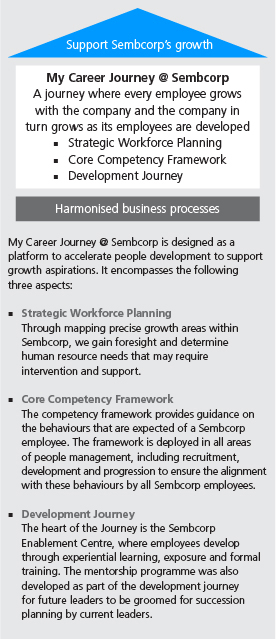
|
The strategy is underpinned by harmonising business processes across our global businesses which increase efficiencies in management, reporting, monitoring and analysing meaningful and comparable information. Sembcorp invested in a recent upgrade of human resource management systems to adopt an identical and seamless system globally.
People development is a key component in our strategy, and is driven at the board level by the Executive Resource and Compensation Committee. We assess our people needs systematically through our strategic workforce planning exercise, which is consolidated, monitored and assessed for criticality at group level. We utilise our Core Competency Framework as a behaviour-based metric to benchmark leadership and job-specific behaviours. The framework is founded upon our core values
of Insight, Integrity and Integral. These competency behaviours are expected of every Sembcorp employee.
We provide development opportunities for all our employees, including external and on-the-job training, international assignments, mentoring, workshops and seminars. Employees are also encouraged to pursue higher qualifications that may be sponsored by the company. We view employee development as a key tool that strengthens our human capital, and every employee is required to review and plan their development goals at every performance appraisal session, administered via our human resource management systems.
|
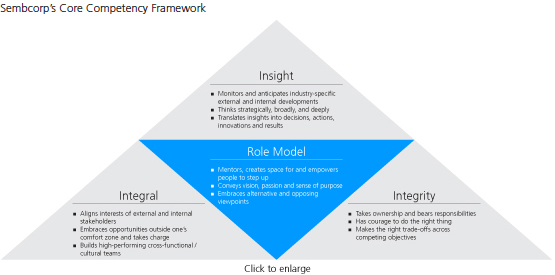
With our headquarters based in Singapore, the Group subscribes to the Principles of Fair Employment formulated by the Singapore Tripartite Alliance for Fair Employment Practices and has endorsed the Tripartite Alliance’s Employers’ Pledge of Fair Employment Practices. These principles, embedded into our human resource practices and implemented by Sembcorp on a global level, include a commitment to:
| – |
Recruit and select based on merit, such as skills, experience and ability, regardless of age, race, gender or family status |
| – |
Treat employees fairly and with respect and implement progressive human resource management systems |
| – |
Provide equal opportunities for training and development based on employees’ strengths and needs, to help them achieve their full potential |
| – |
Reward fairly, based on ability, performance, contribution and experience |
| – |
Abide by labour laws and adopt tripartite guidelines which promote fair employment practices
|
For the convenience of our staff, the policies and guidelines are readily available on our intranet.
The board oversees human resource issues through the Board Risk Committee, Executive Remuneration and Compensation Committee and Enterprise Risk Management Framework with the aim of ensuring that Sembcorp’s human resource needs are aligned with our strategic business plans, and that structures and systems are in place to develop and retain a skilled workforce and competent senior management.
The Senior Management Committee is responsible for setting key policies relating to our people. The Group Human Resource department reviews Sembcorp’s human resource and organisational behaviour concerns and formulates programmes to improve performance, and recommendations for key policies are proposed by the Head of Group Human Resource. The Group Human Resource department coordinates and executes our human resource efforts across our business units, which span six continents.
Sembcorp fully supports the basic principles of human rights and has implemented a number of policies throughout the Group in support of these principles, including fair employment practices and a grievance and harassment policy.
A key tenet of Sembcorp’s business ethics is strict respect for labour laws within each of the countries we operate in, all of which preclude forced or child labour, and is further supported through our policies and employment practices.
Sembcorp employees are entitled to practise freedom of association in the workplace, within the boundaries of each of the jurisdictions under which we operate. Sembcorp’s operations span six continents where labour relations, regulations and practices differ widely. Sembcorp seeks to maintain excellent labour management relations with its unions, and holds constructive ongoing exchanges with employee unions in its various locations.
Decisions on executive remuneration and compensation are made by our Executive Remuneration and Compensation Committee. The Committee reviews and updates the compensation framework annually to ensure Sembcorp employees receive fair compensation and remuneration, and a compensation benchmarking exercise is conducted once every two years to ensure our pay packages are competitive.
Sembcorp offers competitive base pay packages throughout our global businesses that are based on country-specific conditions. Rewards include annual salary increments and annual performance bonuses, as well as longer-term incentives linked to sector practices and performance of the Group, the company and the individual. Share-based incentives remain a key component of the Group’s pay structure for senior management and are deliberately aligned with long-term Group performance objectives; more information can be found in the Corporate Governance section. All employees are eligible for comprehensive insurance coverage on a global basis which is open to eligible dependants.
Sembcorp continues to promote a holistic and balanced lifestyle for our employees, which we believe is good for both their physical and mental health. We encourage employees at our various business units to participate in employee recreational activities throughout the year, including community outreach and volunteering initiatives, team sports events, talks, gatherings and employee family days.
We recognise the importance of engaging with our employees and have various platforms through which we communicate with and receive feedback from our staff. Employees can submit feedback and staff suggestions on a confidential basis through an easily accessible online channel on the employee intranet. We also have an easily accessible whistle-blowing link on our company intranet and employees may also provide feedback via email, mail or facsimile.
Succession planning is an important component of Sembcorp’s leadership development strategy. Our succession planning strategies are overseen by our Executive Remuneration and Compensation Committee. Potential candidates are identified and groomed for succession through mentoring, job rotation as well as skills enhancement training. Senior executives undergo company-sponsored programmes at well-regarded institutes such as Harvard Business School and INSEAD.
In 2012, we refined our “My Career Journey @ Sembcorp” platform to accelerate people development in support of Sembcorp’s growth aspirations. We also formalised our mentorship programme for current leaders to groom and nurture future leaders in line with our succession planning strategy. We are also increasing our investment in leadership development out of our total development expenditure.
We implemented the Team Insights Programme in Singapore which utilises a psychometric profiling tool to enhance self-awareness and help strengthen working relationships in the organisation, leading to increased productivity and business performance.
Sembcorp also upgraded our human resource management systems to manage our employees’ training and development via our business intelligence platform globally.
For further information on our reporting scope, please refer to Our Approach to Reporting.
Further performance information is available here.
Developing the right team of individuals with the right skills, motivation and passion to succeed will continue to be a key focus for us. We will continue to monitor and expand our mentorship programme, and we aim to set up and operationalise the Sembcorp Enablement Centre to capture, retain and transfer core capabilities and competencies among employees. The Centre will play a central role in our employees’ competency development through experiential learning, exposure and formal training.
At Sembcorp, we are committed to the health and safety of our employees and others who visit or work in our premises; and to protect the environment in our business activities through good environmental practices.
We regard the health and safety of our people as top priority, and exercise our duty of care by providing a working environment that goes beyond health and safety regulatory obligations. We are also committed to enforcing safe working practices within our sphere of influence.
As a provider of essential utilities, Sembcorp’s businesses are inextricably tied to environmental issues. We recognise our role as a key player in the utilities sector, and the emerging challenges and risks faced by our businesses. We acknowledge that one of the biggest environmental challenges is the demand for energy that is clean and environmentally friendly, while also secure and cost-competitive. At Sembcorp, we believe that it is our job to meet these challenges with innovative solutions.
Environmental stewardship is an integral part of our operations philosophy. We recognise the importance of environmental issues, especially in light of increasing legal requirements on emissions and discharges, coupled with scarce water supplies as key vulnerabilities that may affect our businesses. As a responsible corporate citizen, we seek to minimise our environmental impacts by continuously ensuring the effectiveness of our Health, Safety and Environment (HSE) management practices and focusing on reduction at source.

Occupational health and safety are of paramount importance in our businesses. With operations in 16 countries across six continents, we recognise the importance of an effective occupational health and safety management approach to prevent health and safety-related incidences, instill sound and practical health and safety regimes, comply with applicable laws and regulatory requirements in all the countries we operate in, and ensure a competent workforce across the organisation.
Given increased urbanisation and industrialisation in emerging economies, there is a growing need to tackle the dual challenges of climate change and an increasing demand for affordable and reliable products and services such as energy and water. Sembcorp believes that we can play a role in enhancing the quality of life and protecting the environment by investing in, and applying advanced technologies and innovations to address our customers’ needs.
In the course of our business activities, Sembcorp believes that we also have a duty to conserve the natural environment and resources. Our businesses consume primary resources and it is in these areas that our responsible stewardship can have the greatest impact.
HSE is integrated as a value-added component in Sembcorp’s Business Development-Project Development-Asset Management work processes, alongside legal and regulatory requirements.

Sembcorp’s Group HSE policy articulates our aspirations with respect to health, safety and environment to our stakeholders. The Group HSE policy is available here.
The Group HSE guidelines outline the roles and responsibilities of various relevant departments and business units, in line with the Group HSE policy. The guidelines were endorsed by the Board Risk Committee. Business units under the management and operational control of the Sembcorp Group have to comply with the requirements set out in the HSE guidelines, and track and monitor standardised key HSE statistics based on our 4/0 targets. The 4/0 targets refer to: zero harm to people, zero damage to the environment, zero damage to assets and zero non-compliance with legal and regulatory requirements.
Sembcorp encourages the implementation of internationally recognised HSE management systems across our operations. Detailed disclosure of certifications achieved by Sembcorp’s businesses is available here.
HSE issues are driven at the board level by the Board Risk Committee, reflecting its top priority. The Board Risk Committee discusses HSE issues quarterly, supported with monthly HSE performance statistics reported by the Group HSE department. HSE statistics are also included in the Monthly Management Report submitted to the board.
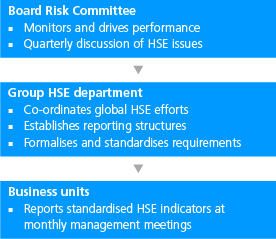
The Group HSE department coordinates our global HSE efforts across our business units and establishes HSE reporting structures. It works closely with regional HSE coordinators to ensure the effective and timely management of HSE issues across the Group.
The Group HSE department also formalises and standardises group-level HSE requirements and guidelines. Standardised HSE indicators are reported at the monthly management meetings of each business unit.
Sembcorp believes that proper arrangements must be made to ensure all employees are competent to maximise their contribution to the organisation’s HSE performance. Training needs are identified, including refresher training and training arising from change in job appointment, legal and / or regulatory requirements, risk control needs and business environment, in consultation with employees.
The Group HSE department also organises a one-day workshop annually to reflect, learn and improve on the past year’s performance. Business units are involved to develop key goals and initiatives for the year.
Periodic HSE audits are conducted to ensure that HSE matters are managed professionally in order to meet legal compliance and ensure continuous improvement in all our activities.
We are committed to the prevention and reduction of workplace injuries and occupational illnesses by active management of risks associated with our activities and services throughout our global operations. Besides the management of workplace safety hazards, we also place focus on the prevention of occupational illnesses. The Group HSE guidelines require all businesses to have in place programmes to manage occupational health hazards. Examples of these programmes include promoting ergonomics for manual handling activities for field operators and professional counselling for employees diagnosed or suspected with noise-induced hearing loss.
Sembcorp recognises that risk assessment is the cornerstone of effective health and safety management. We seek to ensure that all hazards have been identified and their risks assessed at all relevant life cycle stages: pre-bid due diligence study, design, construction, operation and decommissioning phases.
We implement suitable control systems such as engineering safeguards (including guards, interlocks, and local exhaust ventilation) and procedural safeguards (including permits to work, adequate training and supervision) to prevent harm to people and equipment at the point of risk. We emphasise the importance of providing and maintaining adequate workplace controls throughout the entire operation process.
As a global energy player, we recognise that investing in energy efficiency, renewables and low-carbon technologies not only helps to manage emissions, but also makes business sense. Be it the use of energy-efficient technologies, alternative fuels or optimising fuel mix, these are critical issues that both nations and corporations will increasingly have to grapple with.
By actively engaging the policy makers, academic institutions, industry peers and customers, Sembcorp keeps abreast of developments pertinent to climate change. Our Group President & CEO serves as a member of Singapore’s Climate Change Network, a multi-sector network spearheaded by the National Climate Change Secretariat for dialogue on climate change issues. Our Technology department collaborates with academic and research institutions, technology suppliers and end users to develop and continuously improve our processes, ensuring the optimisation of our facilities.
Sembcorp is committed towards conservative use of energy, by focusing efforts on setting strategies to mitigate climate change, and achievable renewable energy and energy efficiency targets as key drivers and growth opportunities for our businesses. A portfolio of high-efficiency assets with a diversified fuel mix enhances the management of risks, cost, and ultimately helps us stay competitive. We achieve this through a three-pronged approach.
Firstly, Sembcorp aims to maintain and develop a diverse generation portfolio involving a range of different technologies and energy sources. Sembcorp is Singapore’s first commercial importer and retailer of natural gas. The majority of Sembcorp’s power generation facilities are fuelled by natural gas.
Secondly, Sembcorp maintains highly efficient, state-of-the-art generation plants for producing energy competitively with low emissions, and create innovative solutions for clean, sustainable water. We incorporate energy efficiency considerations across design, operation and maintenance phases. We ensure the technical integrity of facilities and installations through effective maintenance programmes and proactive asset management initiatives. This includes the regular review of our operating efficiency and implementation of energy efficiency programmes.
Thirdly, Sembcorp will continue to explore opportunities to grow our current renewable energy and low carbon intensity portfolio via acquisition or organic growth. Our green facilities include a large biomass station in the UK, energy-from-waste operations in Singapore and wind power assets in China. To date, Sembcorp has a total of 283 megawatts of renewable power capacity.
At Sembcorp, our operations are focused on ensuring that adequate resources are allocated to maintain environmental quality where we operate.
Environmental studies are carried out in accordance with national and / or international standards and methodologies for new major projects and expansions. These studies include environmental impact assessments, environmental baseline studies and pollution control studies. All recommendations put forth from the assessments form part of our management of HSE risks and are incorporated in the planning, design, construction and commissioning of the new plants.
Our management approach to reduce fuel consumption and increase energy efficiency concurrently reduces atmospheric emissions. We also minimise atmospheric emissions through various technologies, including catalytic convertors and adjusting combustion temperatures for nitrogen oxides (NOx) and carbon dioxide (CO2) control. Emission levels are monitored at our energy plants, where emissions are significant.
Our wastewater treatment facilities treat high organic concentration and high salinity industrial wastewater for customers to ensure their wastewater meets discharge standards. Water quality is sampled regularly for testing based on criteria relevant to the nature of the water product: drinking, demineralised or wastewater. Sembcorp’s facilities are able to treat high concentration wastewater with chemical oxygen demand of up to 19,000 milligrammes per litre and high salinity wastewater with salinity of up to 50,000 milligrammes per litre directly from source. Water quality is tested on a daily basis to ensure water products meet internal and external standards. Sembcorp also reclaims water from treated effluent, which minimises liquid discharge and conserves water resources. This integrated closed-loop approach offers a sustainably-sourced alternative to industries and households.
All hazardous waste are disposed in accordance with local regulations. In the instance of an emergency arising from major spillage or hazards, emergency response plans will be activated.
Sembcorp actively develops differentiating know-how which can reduce waste going to incineration or landfill facilities, including energy-from-waste capabilities. An example is our woodchip-fuelled biomass steam production plant, which uses wood waste collected by our solid waste management arm to produce economical steam. This demonstrates our unique capabilities to manage the entire energy-from-waste value chain, by leveraging the expertise in our solid waste management and energy businesses.
To support Sembcorp’s rapid global growth, the key goal for the Group HSE department in 2012 was to reiterate the importance of the HSE Management System Framework to ensure that all businesses under our management and operational control operate and manage HSE issues under the same framework. Conformance to the Group HSE guidelines was ensured through HSE audits conducted at the business units, such as our water plants in China. For newly commissioned greenfield plants, Group HSE participated with the team on site to support the development and implementation of a HSE management system that is aligned with the Group HSE guidelines requirements.
Injury rate and lost day rate are measured per 200,000 man-hours, which is roughly equivalent to hours worked by 100 full time employees in a calendar year. As it is not meaningful to illustrate ratios such as injury rates and lost day rates across years for different scopes, the charts below illustrate data from a common scope from 2010 to 2012. This is the same scope presented in the Sustainability Performance Snapshot. For detailed clarification on scopes, please refer to Our Approach to Reporting. There were no fatalities in 2012.
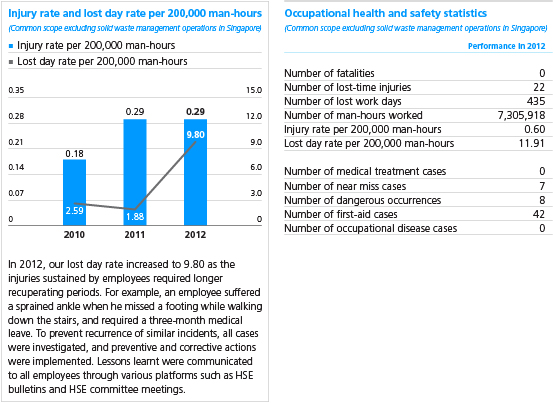
Solid waste management operations in Singapore are excluded from the common scope for more meaningful comparison and analysis, as the solid waste management operations employ manual labour to a greater degree and have a different risk profile from other Utilities businesses.
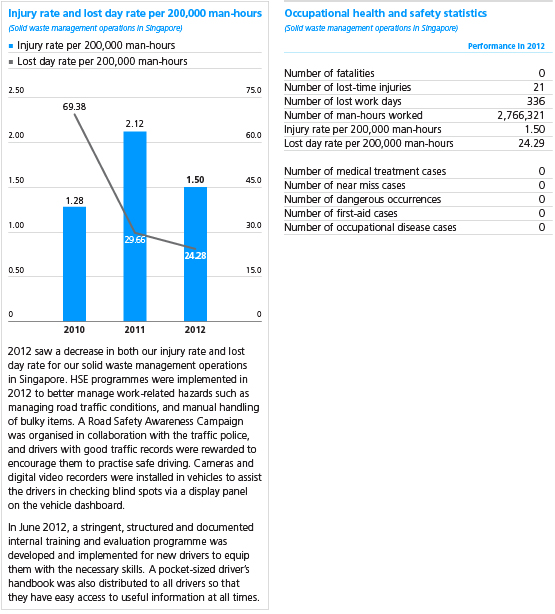
Definitions of the above parameters are available here.
In 2012, we diversified our energy portfolio. Through an acquisition of four wind power assets in China, we increased our renewable energy capacity in operation and under development to approximately 5% of our Group’s total power portfolio.
Our NOx emission was 3,555 tonnes and sulphur oxides (SOx) emission was 1,795 tonnes. We registered a slight decrease in our SOx emissions from 2011, but an increase in NOx emissions. The increase in NOx concentration was attributed to the higher quantity of fuel oil used by our Singapore operations due to a period of natural gas curtailment during the year. These emissions continued to be below regulatory limits.
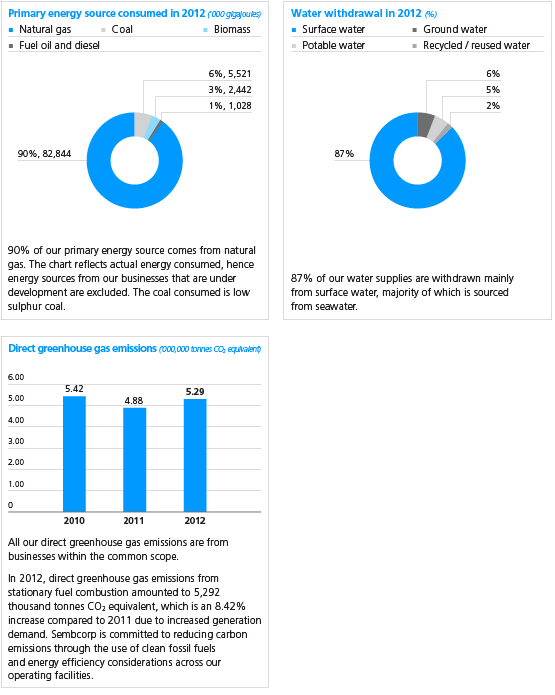
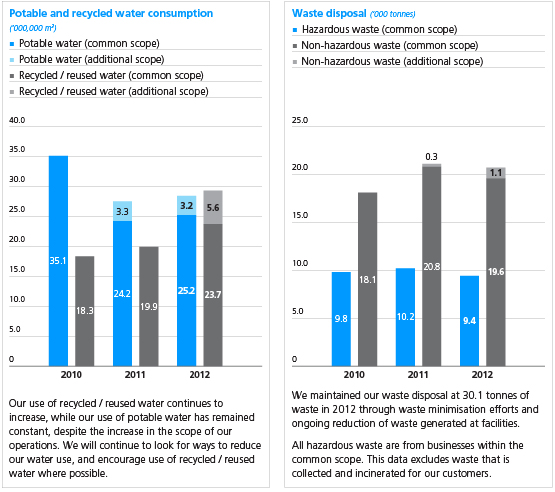
For detailed clarification on scopes, please refer to Our Approach to Reporting.
Going forward, Sembcorp aims to strengthen our governance of HSE management at our work sites through collaboration with Group Internal Audit to formalise and conduct regular HSE conformance audits.
We recognise the need to enhance our existing management of project risks to reduce and prevent severe incidents and lost-time injury cases for our projects. The Group HSE department is working towards formalising HSE guidelines at the group level with the Group Project Development department for implementation in all our global projects.
With our evolving and expanding global portfolio, we seek to ensure that our management approach and systems are aligned with the needs and differing contexts of the businesses. Close monitoring and appraisal of our occupational health and safety performance will be tagged closely to the key performance indicators which will include both lagging and leading indicators for continuous improvements.
As part of our carbon conservation efforts, Sembcorp aims to benchmark its corporate carbon footprint, through development of a carbon management system based on the ISO 14064 standard. The first phase of this measurement will cover our Singapore operations.
In support of Energy Efficient Singapore, an initiative by Singapore’s Energy Efficiency Programme Office, the Sembcorp corporate office will be embarking on a comprehensive energy audit covering an extensive assessment of the existing building’s major energy consuming system, which will be used for benchmarking against design efficiencies to quantify potential energy savings through efficiencies enhancement measures.
We are also working towards identifying and developing competencies of employees responsible for managing and reporting environmental issues at each business unit. This will ensure that our competencies are aligned across our global operations to maintain high standards of environmental management practices for the Group. We believe that this will help Sembcorp meet evolving and increasingly complex environmental business challenges ahead.
As a global company with operations across six continents worldwide, we recognise the importance of being a responsible business that contributes positively to our communities. Our long-term success is premised upon being an integral part of the communities we are in, and we aim to contribute positively, directly or indirectly, to the local communities in which we operate.
At Sembcorp, we are committed to assessing and responsibly managing our impact, as well
as investing in the local communities in which we operate.

Sembcorp provides essential solutions that are indispensable to everyday life. As vital partners to our host communities, we play an integral part in the development and progress of the community, and believe that when the community prospers, we grow in tandem as well. Doing our part for the community exerts a positive effect on our businesses, helping us build mutually beneficial relationships with communities, governments and business partners.
At Sembcorp, we understand that the needs of each community can be very different from one another, and therefore, our local sites can better understand and serve local needs.
Community integration is managed at the local level, with the Group providing tools, frameworks and guidelines to ensure consistency and acceptable standards in assessment, engagement and development plans.
We believe that assessing and responsibly managing our impact on local communities is key to successful community integration and acceptance. Environmental impact studies are carried out in accordance with national and / or international standards and methodologies for new major projects and expansions. Some of these studies include social impact assessments and social management plans which are implemented through the various stages of the site’s development.
We seek to nurture open communication in the communities we operate in. At our local sites, various communication platforms including community liaison panels and meetings, newsletters, telephone and email contacts are utilised.
Sembcorp’s Global CSR Framework establishes a strategic and consistent approach for investing in the communities in which we operate. We invest our resources where we can engage in issues that are important to the local community and which are aligned with our core businesses. We focus on two areas:
| • |
We are committed to fostering environmental stewardship in our community through contributions to sustainability and environmental initiatives.
|
| • |
We are committed to improving the living standard and quality of life of the community, such as through providing access to energy and water, social welfare and education. |
Our framework also aligns the tracking and reporting of our community investments with guidelines set by the London Benchmarking Group. This allows us to account for our total community investment using standard definitions and valuations, ensuring that contributions recorded are meaningfully spent on community investment activities.
In 2012, we launched our Global CSR Framework.
We also maintained our ongoing commitment to support the local communities in which we operate through community investment as well as development programmes. Apart from the community investment of over S$900,000 made during the year across our global operations, numerous initiatives were undertaken including youth development, environmental and water conservation education as well as apprenticeship and job training programmes. In 2012, 64% of our operations had local community engagement and development programmes.
In order to assess and responsibly manage our impact on local communities where we operate, we performed a group review across our operations on the availability of impact assessment studies, community engagement processes and channels, and community development programmes.
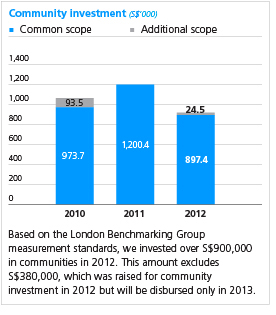
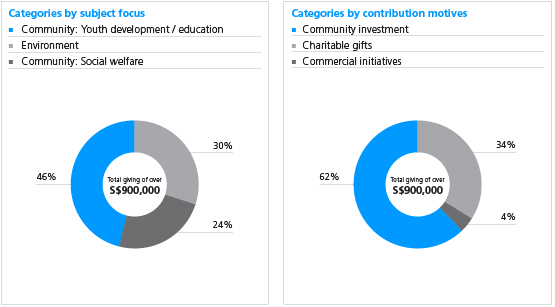
For more information on our community initiatives, please refer to Sembcorp in Our Communities here.
Going forward, our focus is to enhance group-wide frameworks and guidelines for impact assessments, engagement and development plans for our global operations. We also plan to incorporate social impact risk assessments into our pre-investment approval process and our existing Enterprise Risk Management Framework.
To ensure we are making a positive contribution to the communities in which we operate, we will continue to support our global businesses to achieve greater alignment with the Global CSR Framework.
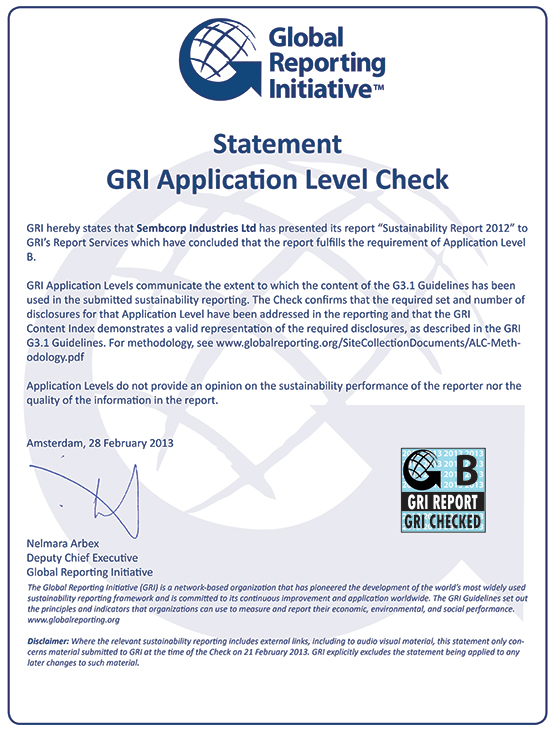
|
|
|
|